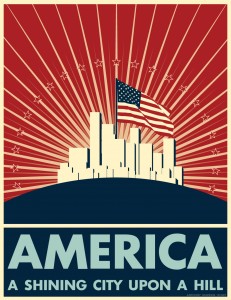I’d like to wish all my readers and friends a very joyous Thanksgiving. Thanksgiving, of course, is a commemoration of our shared American ur-Kumbayah moment, when representatives of the earliest components of the Great American Melting Pot (to utilize that memorable phrase from School House Rock) sat down together to share a feast celebrating coexistence and cooperative economics. Or something of the sort; the message(s) of Thanksgiving is wonderfully elastic.
Utopianism, the notion that human societies are capable of being perfected, that proper planning or design or cultivation of particular personal disciplines could abolish conflict, hunger, misery, and want, has a long history in America, and in fact goes to the very roots of the nation’s founding. According to Wikipedia’s entry on “Shining City On a Hill,”
“Still aboard the ship Arbella, [Puritan leader] Winthrop admonished the future Massachusetts Bay colonists that their new community would be a ‘city upon a hill’, watched by the world. Winthrop’s sermon gave rise to the widespread belief in American folklore that the United States of America is God’s country because metaphorically it is a Shining City upon a Hill…”
Columnist Matthew Continetti has written a fascinating, and I think very useful, brief history of American Utopianism in the online edition of The Weekly Standard. He doesn’t take his chronology all the way back to the Puritans aboard the Arabella approaching what they would call New England, but he could have. Instead, he begins his story with the address of Welsh businessman and political theorist Robert Owen to a joint session of Congress on February 25, 1825. Owen proposed the creation of New Harmony, to be located on the Wabash River in southwest Indiana, a planned community whose virtues would “lead to that state of virtue, intelligence, enjoyment, and happiness, in practice, which has been foretold by the sages of past times, and would at some distant period become the lot of the human race!”
Continetti continues his story through nearly another two hundred year span, mentioning the utopian communities in Brook Farm and Oneida, and explaining the division of utopian thought into two competing streams: Marxism and anarchism, whose proponents could sometimes work as allies of convenience but who would almost invariably come into conflict. His story culminates with our contemporary Occupy Wall Street movement, which itself contains competing strands of Marxist socialism and anarchist socialism.
So, in honor of the Puritans, those members of the counterculture (of their day) who bestowed upon us this turkey- and football-filled celebration of the Shining City Upon the Hill, I recommend to you this pithy and insightful history of American Utopianism. Learn and enjoy!





